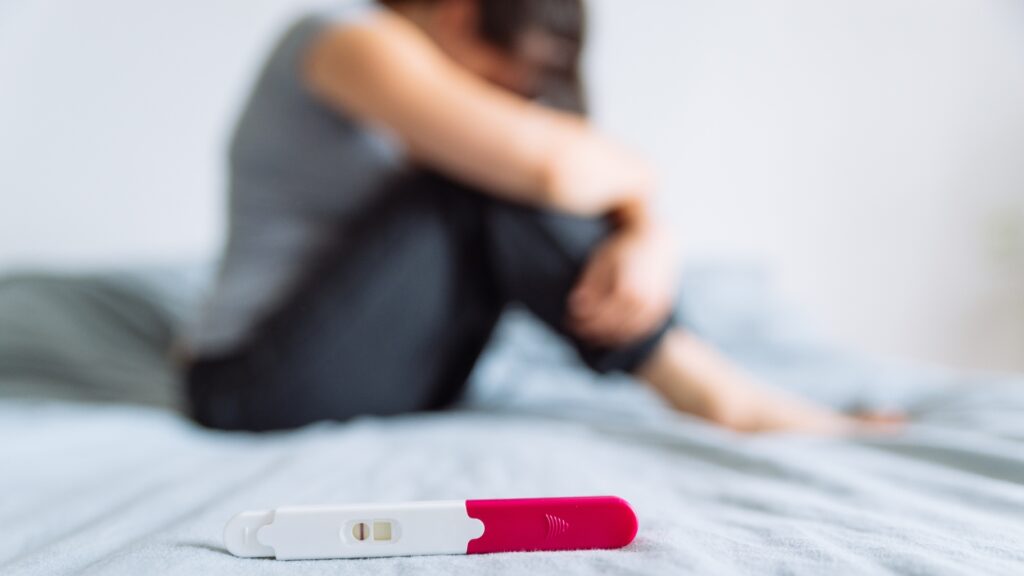Ovulation in Women – Ovulation Symptoms That Aren’t Good Signs
This post was last updated on November 17th, 2023
Awareness about ovulation is crucial for women and girls, as it plays a significant role in reproductive health and family planning.
Ovulation in women which is the process that includes release of a mature egg from the ovary, which typically occurs around the middle of the menstrual cycle. Understanding the menstrual cycle help educating women and girls about the menstrual cycle, emphasizing that ovulation usually occurs around the 14th day for those with a regular 28-day cycle. As ovulation is a key factor in fertility.
Understanding the timing of ovulation is essential for couples trying to conceive or avoid pregnancy. Raising awareness about physical signs of ovulation, including changes in cervical mucus, a slight increase in basal body temperature, and mild pelvic pain can help in maintaining overall health, stress levels, and lifestyle factors can influence ovulation. Helping women to understand the process of ovulation for effective contraception, especially for those using fertility awareness-based methods.
Hence by increasing awareness about ovulation, women and girls can gain valuable insights into their reproductive health, enabling them to make informed decisions about family planning, fertility, and overall well-being. Accessible information and open conversations contribute to empowering individuals to take control of their reproductive health.

Contents
ToggleSignificance of Ovulation
Ovulation is a significant event in a woman’s menstrual cycle with various implications for reproductive health and overall well-being.
Here are some key aspects highlighting the significance of ovulation:
1. Fertility and Reproduction
Ovulation in women is essential for conception and pregnancy. It is the process by which a mature egg is released from the ovary and becomes available for fertilization by sperm.
Understanding ovulation is crucial for couples trying to conceive, as the fertile window—when pregnancy is most likely to occur—typically coincides with ovulation.
2. Menstrual Cycle Regulation
Ovulation is a key component of the menstrual cycle. Its regular occurrence is an indicator of a healthy reproductive system.
Menstrual cycles are divided into two phases: the follicular phase (before ovulation) and the luteal phase (after ovulation). The length and regularity of these phases contribute to overall reproductive health.
3. Hormonal Changes
Ovulation is triggered by a surge in luteinizing hormone (LH) and is influenced by the balance of other reproductive hormones, including estrogen and progesterone. Hormonal changes during ovulation can impact mood, energy levels, and libido.
4. Fertility Awareness and Family Planning
Knowledge of ovulation is central to fertility awareness-based methods of family planning. Women can track their menstrual cycles to identify fertile days, aiding in both achieving and avoiding pregnancy.
5. Health Indicators
Regular ovulation is often considered a sign of good reproductive health. Irregularities in ovulation or anovulation (lack of ovulation) may be indicators of underlying health issues or hormonal imbalances.
6. Symptoms and Signs
Ovulation is associated with certain physical signs, including changes in cervical mucus, a slight increase in basal body temperature, and, for some women, mild pelvic pain (mittelschmerz).
Monitoring these signs can help women identify their fertile window and plan accordingly.
7. Aging and Fertility
Understanding the significance of ovulation becomes crucial as women age. Fertility declines with age, and awareness of ovulation is essential for family planning decisions.
8. Empowerment and Informed Choices
Knowledge about ovulation in women, empowers women to make informed choices about their reproductive health, contraception, and family planning. Open conversations and education about ovulation contribute to a woman’s overall sense of agency and control over her reproductive journey.
Hence, the complete ovulation is a critical biological process that not only facilitates reproduction but also serves as a window into a woman’s reproductive health. Awareness and understanding of ovulation contribute to informed decision-making, effective family planning, and the promotion of overall well-being.

Common Symptoms of Ovulation
Ovulation is a complex biological process, and while not everyone experiences noticeable symptoms, some women may observe changes in their body during this phase of the menstrual cycle.
Common symptoms of ovulation include:
1. Changes in Cervical Mucus
Increased Wetness: Around ovulation, cervical mucus tends to become clearer, more slippery, and similar to the consistency of raw egg whites. This change is favourable for sperm movement and survival.
2. Changes in Basal Body Temperature (BBT)
Temperature Increase: Basal body temperature typically rises slightly after ovulation. Tracking daily temperatures with a basal body thermometer can help identify the shift.
3. Mild Pelvic Pain (Mittelschmerz)
- One-Sided Discomfort: Some women may experience mild pain or twinges on one side of the lower abdomen, known as mittelschmerz. This discomfort is thought to result from the release of the egg from the ovary.
4. Breast Tenderness or Sensitivity
- Increased Sensitivity: Hormonal changes during ovulation can cause breast tissue to become more sensitive or tender.
5. Increased Libido
- Heightened Sexual Desire: Some women may experience an increase in libido or sexual desire around the time of ovulation, possibly as a result of hormonal fluctuations.
6. Heightened Senses
Enhanced Smell and Taste: Some women report heightened senses, particularly an increased sensitivity to smell and taste, during ovulation.
7. Mood Changes
- Increased Energy: Some women may experience a boost in energy and mood during ovulation.
- Slight Mood Swings: Hormonal fluctuations can lead to mild mood changes, though these are generally subtle and vary among individuals.
8. Abdominal Bloating
- Feeling Bloated: Some women may notice mild bloating or a feeling of fullness in the abdominal area during ovulation.
9. Spotting or Light Bleeding
- Ovulation Spotting: A small number of women may experience light spotting or bleeding around the time of ovulation. This is known as ovulation spotting.
10. Positive Ovulation Predictor Kit (OPK) Result
- Surge in LH Hormone: Ovulation predictor kits detect the surge in luteinizing hormone (LH) that precedes ovulation. A positive result on an OPK can indicate that ovulation is likely to occur soon.

Symptoms of Ovulation That Aren’t Good
While many women experience mild and natural symptoms of ovulation in women and some signs or symptoms may be associated with underlying health issues or discomfort. It’s important to differentiate between typical ovulation symptoms and those that may warrant medical attention.
Here are some ovulation-related symptoms that may be considered concerning:
1. Severe Pelvic Pain
While mild pelvic discomfort or twinges (mittelschmerz) are common during ovulation, severe or persistent pelvic pain could indicate other issues such as ovarian cysts, endometriosis, or pelvic inflammatory disease.
2. Unusual Vaginal Discharge
While an increase in clear, slippery cervical mucus is normal during ovulation, any unusual or foul-smelling discharge may be a sign of infection and should be evaluated by a healthcare professional.
3. Painful Intercourse
Ovulation itself should not cause pain during intercourse. If sexual activity is consistently painful during ovulation, it may be a sign of an underlying issue such as infection or endometriosis.
4. Excessive Bleeding
While spotting or light bleeding may occur in some women during ovulation, excessive or heavy bleeding is not a typical ovulation symptom and may require investigation.
5. Irregular Menstrual Cycles
If a woman consistently experiences irregular menstrual cycles or ovulation is not occurring regularly, it may be a sign of hormonal imbalances or other reproductive health issues.
6. Chronic Fatigue or Exhaustion
While a temporary increase in energy is reported by some women during ovulation, chronic fatigue or exhaustion may indicate other health concerns unrelated to the menstrual cycle.
7. Persistent Mood Changes
While mild mood changes are common due to hormonal fluctuations, persistent or severe mood swings, anxiety, or depression may be indicative of other mental health or hormonal issues.
8. Difficulty Breathing or Chest Pain
Ovulation should not cause respiratory issues or chest pain. If a woman experiences difficulty breathing or chest pain during ovulation, it’s important to seek medical attention.
9. Signs of Infection
Symptoms such as fever, chills, nausea, or any signs of infection during ovulation may indicate a health issue unrelated to the normal ovulatory process.
It’s important to note that not everyone experiences these symptoms, and the intensity and presence of symptoms can vary from cycle to cycle. Tracking these signs can be helpful for women trying to conceive, practicing fertility awareness, or understanding their menstrual cycle better. Additionally, consulting with a healthcare professional for personalized guidance is recommended, especially for those experiencing irregular cycles or fertility challenges.
If a woman experience any of these symptoms during ovulation, or if there are concerns about reproductive health, it’s advisable to consult with a healthcare professional. Regular gynaecological check-ups and open communication with a healthcare provider are essential for addressing any concerns and ensuring optimal reproductive health.
You may like this
Recommended For You
The Benefits of Home Eldercare Services
Priyadarshini Muduli
A full time passionate writer with imperishable determination to bring healthy, smart and pragmatic changes individually and socially. Concentrate especially on lifestyle, life and personal improvement, relationships, mental health and behavior, viral issues and literature based subjects.




